
BY VINCENT P. MULRAY
On the evening of May 12, 2015, as I was documenting daily staffing and reviewing incident reports, just a few miles to the east, on one of the busiest and fastest rail lines, a passenger train was departing from the 30th Street Station and heading to New York City. At 9:28 p.m., the public address system at the Kensington and Castor Avenue fire station dispatched my resource identifier-Battalion 10. Within a minute, I was heading to a passenger train derailment that would challenge first responders and supporting agencies.
Phil McLaughlin, a Philadelphia (PA) Fire Department retired deputy commissioner, often said, “Experience is our hardest teacher-it gives us the test first, then the lesson,” emphasizing the benefits of simulated emergency incident training and the study of past emergency responses. Our department was tested on that night when Amtrak Train 188, traveling at more than 100 miles per hour, derailed and crashed at Frankford Junction, killing eight passengers and injuring more than 200 others. At 9:28 p.m., a full box assignment-four engines, two ladder companies, two battalion chiefs, one rescue, and one medic unit-were dispatched to Coral Street and Wheatsheaf Lane for a train derailment. Additional information requested en route identified it as an Amtrak passenger train. My past work experience, running passenger trains on these same tracks and doing extensive research on passenger train crashes, train bombings, and assessing the Center City commuter rail tunnel, would all serve as a base of knowledge required for this incident.
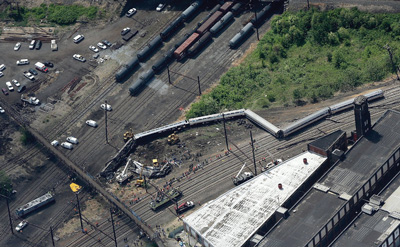 |
 |
| (1, 2) An aerial view of the derailment shows the large area over which it extended, requiring that the scene be split into two manageable geographic divisions, initially called East (including the locomotive and cars 1-4) and West (cars 5-7). The locomotive is at the far left, car 1 in the center, cars 2 through 4 lie on their sides, car 5 is upright and perpendicular to the tracks, and cars 6 and 7 are upright to the right. (Photos 1 and 2 by the National Transportation Safety Board; all other photos by Greg Masi.) |
Frankford Junction is a former railroad station with an active rail yard approximately three miles from Amtrak’s North Philadelphia Station. Amtrak’s Northeast Corridor line travels through this area on four tracks that form an S curve with a 50-mile-per-hour (mph) speed limit for all trains, the slowest track speed limit between Washington D.C. and New York City, the train’s final destination. The junction was well known to first responders and local residents because of a previous accident. On September 6, 1943, the Congressional Limited, traveling nonstop from Washington, D.C., to New York City, derailed in the same general area, killing 79 of the 541 passengers. Local residents called this area a “dead man’s curve.”
 |
| Figure 1. Amtrak Derailment Response Operations |
Amtrak train records indicated that on Train 188, an emergency application of its brakes occurred at approximately 9:20 p.m. The fire department’s 911 call center received its first notification at 9:27 p.m. and dispatched a full box assignment at 9:28 p.m. for a derailed train, which would be elevated to a four-alarm response before being placed under control. Approximately 180 firefighters, emergency medical technicians, and paramedics were summoned. The Philadelphia Police Department sent approximately 200 working district officers, who provided scene control and acted as stretcher bearers.
The first-arriving units from the Kensington and Castor Avenue fire station half a mile away-Engine 7, Ladder 10, and Battalion 10-staged on the eastern end of Wheatsheaf Lane, above the Main Line tracks. On arrival, members opened a padlocked chain-link fence that protected the railroad right-of-way. Numerous walking wounded funneled their way toward the lights of responding companies and onto Wheatsheaf Lane. My initial size-up revealed that a passenger train was on its side some 400 feet from the gate, with several cars on the Main Line and some in the Frankford Junction yard. Hundreds of passengers were observed evacuating across the tracks in the western side of the incident to Frankford and East Sedgley Avenues. A complete 360° visual assessment was completed with direct observation and radio reports from the first-due engine and ladder companies. A tangle of down catenary poles and 138,000-volt transmission lines and 13,200-volt catenary wires blocked the Main Line track. Initial reports I received indicated that numerous passengers were injured; a second report revealed that many passengers needed extrication.
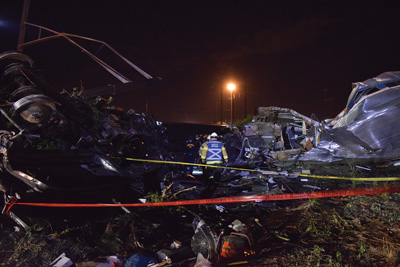 |
| (3) Shutting down all rail traffic and electrical power to Amtrak’s busy Northeast Corridor was among the initial incident objectives. The safety officer surveys the wreckage of car 1, the most severely damaged. |
The electric locomotive and all seven passenger cars were derailed. The locomotive came to rest some 200 feet beyond the lead car. Assigning each car a number aided in breaking down the scene into manageable geographical areas for an effective and efficient span of control, which aided extrication operations.
The first car (car 1) was the most severely damaged and, in the dark, almost unrecognizable. Cars 2, 3, and 4 were resting on their sides with the emergency windows facing upward. Car 5 was upright and perpendicular to the track with little damage. Cars 6 and 7 were derailed, fouling the Main Line tracks. The Southeastern Pennsylvania Transit Authority and, from 10 p.m. to 6 a.m., freight railroads also operate on these tracks.
I made a second report to the fire communication center conveying the current status of the incident and requested a full second-alarm assignment and five more medic units for a total of 10 on scene. Before it was brought under control, this incident would be classified as a mass casualty level three response, with a total of 18 medic units responding.
To treat and transport more than 200 patients, we needed full community support and coordination. The Philadelphia Office of Emergency Management sent its communication vehicle, and a mobile emergency operations center (EOC) was established on scene to request and track all agencies that supported fire department operations. Agency administrators reported to the mayor at the EOC for policy, mission, direction, and authority. Uninjured passengers were sheltered and transported on buses.
My focus for this incident was to operate at the strategic level. My initial incident priorities focused on the scene’s safety and security. This derailment occurred on Amtrak’s Northeast Corridor, one of the busiest and fastest rail lines in the United States.
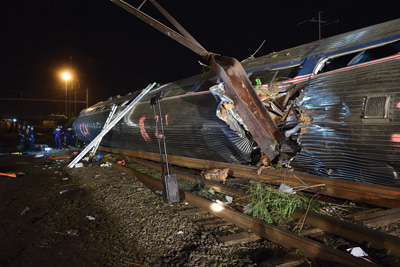 |
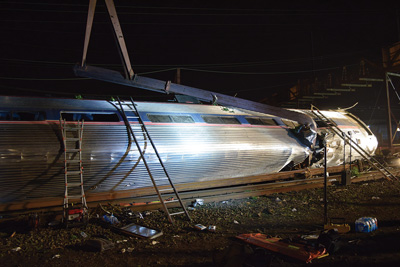 |
| (4, 5) Car 2 lies on its side. A catenary pole penetrated its stainless-steel body. Portable battery-powered LED lighting illuminates the scene. Responders used numerous portable ladders to access the windows of each of the four overturned rail cars. Portable generators and hydraulic extrication equipment are staged outside the car. |
Initial Incident Priorities and Objectives
My initial incident priorities and objectives were to ensure responder and passenger safety, stabilize the incident, assess the incident’s environmental impact, and establish and maintain scene management.
The initial incident objectives for this incident were as follows:
- Shut down all rail service to Amtrak’s Northeast Corridor.
- Deenergize all electrical catenaries and transmission lines to this area. All requests to shut down rail service to the Northeast Corridor and to deenergize electric catenaries were relayed to Communications (Battalion 10’s field incident technician) and then to the Philadelphia Fire Department’s Fire Communications Center. Five separate radio transmission requests were transmitted in the first hour of operation.
- Request a second alarm with five additional medic units.
- Establish unified command, announce the name and the location of the command post, identify a staging area, and manage incoming fire apparatus to allow for access and egress of later-arriving medic units. The initial responder staging area was on the east end of Wheatsheaf Lane by Frankford Avenue. Wheatsheaf ultimately became the location of the command post; the mobile EOC; firefighter rehab; and, initially, the East Division patient triage, treatment, and transport operations.
- Divide the scene into the East Division (cars 1-4 and the locomotive) and the West Division (cars 5-7). The East Division operations were centered on the east end of Wheatsheaf Lane. The West Division patient triage, treatment, and transport were located at the intersection of Frankford and East Sedgley Avenues (Figure 1).
- Continue the size-up of the entire scene to grasp the scope of this incident. I accomplished this by direct observation and through the radio reports from the first engine and ladder companies operating inside the overturned rail cars.
- Remove all passengers from the train; establish casualty collection, triage, and treatment; and coordinate transportation of all passengers.
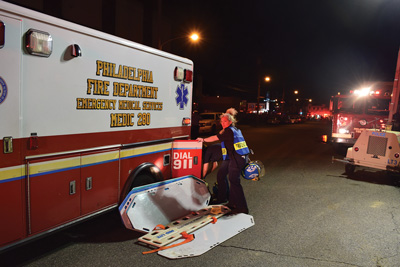
(7) Establishing a triage section was part of the initial incident strategy. Medic 22 members prepare to establish the primary triage area for the East Division on Wheatsheaf Lane. Usually, the senior paramedic on the first advanced life support ambulance is the triage group supervisor.
Initial Strategy
The initial strategy was to assign companies to each division, assign multiple companies to each passenger car, and deploy second-alarm companies to fortify all divisions and groups. A triage section was established with the first medic unit on the east end of Wheatsheaf Lane and was supplemented by later-arriving units. A water supply was established, and a three-inch line was stretched to the scene (photo 3).
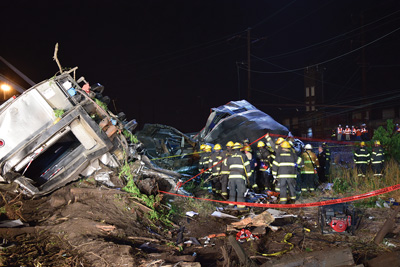 |
| (6) Initial companies were directed into the most severely damaged cars: car 1, on the right, and car 2, on the left, overturned. |
Critical Factors Affecting Operations
Life. Initial size-up challenges revolved around identifying the number of rail cars and the number of passengers onboard. Initial observation estimated that approximately 10 cars were involved in the derailment. A secondary and continuing size-up revealed that seven passenger cars and one electric engine had derailed. There were 236 passengers and five Amtrak employees onboard, according to a train conductor who was evacuating the scene.
Lighting. Lighting was one factor that impacted fire department operations. At 9:30 p.m. on May 12, 2015, the last quarter moon cast little light on the desolate and remote Frankford Junction rail yard, which was unlighted, and there was no indirect lighting from the distant surrounding neighborhood. The lack of light impaired my ability to view the entire area without walking the entire scene, thus affecting the scene size-up. Operating personnel depended on handheld flashlights as the initial source of lighting. Portable lighting and, finally, portable generator-powered area lighting were established approximately two hours into the incident, after most of the passengers were evacuated. The darkness also affected self-evacuating passengers making their way through the debris field over uneven, unlighted ground.
Weather. The weather for this night was 82˚F with winds out of the west at 20 mph, with clear skies. Although the weather was not extreme, it did require calling for support services early in the incident. A canteen unit (the Philadelphia Second Alarmers Association) was requested to provide drinking water and assist with rehab.
Auxiliary Appliances. Lighting up the scene was a priority early in the incident. Handheld flashlights were inadequate to illuminate large areas. Fire department special operations companies and the Philadelphia police provided battery-powered LED lighting. Operations required combining three of these lights to illuminate each of the 80-foot-long passenger cars.
Height of Cars. Resting on their sides, the top of the passenger cars were approximately 11 feet above the ground. The first-arriving ladder companies’ initiative in bringing portable ladders to the scene was instrumental in accessing the cars through the emergency windows and removing stranded passengers. The smooth stainless-steel sides of the cars offered no natural access points while on their sides. The side doors were not operational; most people were removed from the end doors or the windows.
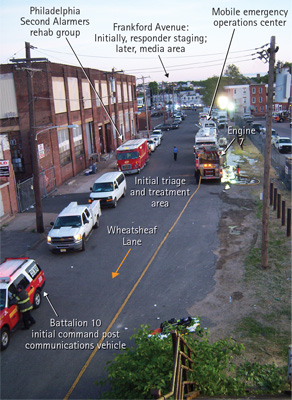 |
| (8) With its wide area, the east portion of Wheatsheaf Lane provided ample space for the large number of patients needing triage, treatment, and transport. After patient care was completed, this became the center for firefighter rehab. The hoseline guided passengers to medical treatment. |
Exposures. Multiple stored freight cars were close to the crash site. Even though they were not involved, they were moved later in the incident to provide better scene access. Their contents, if any, were unknown, but none of the cars were placarded.
Area of crash. The area of the crash spread out 600 feet across the rail yard and the Main Line. The incident operating area that included the rail yard was an estimated half-mile long and a quarter-mile wide. This large area challenged later responding units and required duplicating patient triage, treatment, and transportation arrangements in the East and West Divisions (Figure 1).
The initial fire department command post was on Wheatsheaf Lane close to the mobile EOC. Later, the fire department command post was relocated closer to the derailment site.
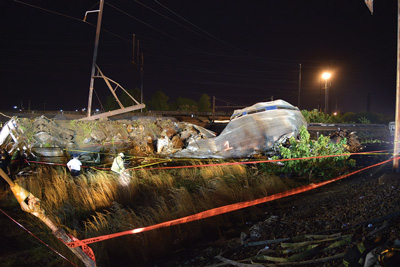 |
| (9) Looking down from the Main Line on the crash site. At bottom right is the hoseline stretched to the scene to protect the responders and the passengers in case of fire. It also guided the walking wounded to the East Division patient treatment area. On the right is car 1, marked with orange spray paint; car 2, overturned, is on the far left. |
Topography. The crash scene’s topography challenged responders and passengers evacuating the crash site. Amtrak’s Main Line through Frankford Junction was on a sharp curve, and the tracks were banked to accommodate trains traveling at 50 mph. The derailment displaced the concrete ties and twisted the rails. The Main Line’s railbed was elevated above the freight yard, so the responders and the passengers had to transverse down the steep, debris-laden slope of disturbed ballast. To the east, the passengers followed the yellow three-inch hoseline that identified and marked the exit route approximately 400 feet to the triage area. To the west, the triage area was an 800-foot walk from the site to Frankford and East Sedgley Avenues.
Transition Plan. The transition plan was intended to achieve a safe and an effective transfer of command. At approximately 9:52 p.m., a face-to-face transfer of command to Division Chief 2 was completed. He was briefed on the current incident scene conditions, the actions already taken, the activities ongoing, and the future needs essential to accomplish the department’s mission to provide for the welfare and safety of responders and passengers. The transfer of command was announced on all fireground and dispatch radio frequencies to ensure a smooth transition. After the transfer, I was reassigned to the East Division to control and coordinate activities.
 |
| (10) Continuous size-up of the extensive scene revealed many challenges that taxed emergency responders’ resources. The locomotive came to rest approximately 150 feet beyond car 1, near where rail tank cars were stored. This tank car that impeded access to the scene was later moved away. |
Lessons Learned and Reinforced
- As Dwight D. Eisenhower said, “Plans are worthless, but planning is everything.” This railroad junction was identified as a target hazard for this area. Although no formal written plan was produced, numerous site visits familiarized responders with the area’s physical characteristics and benefited responders in gaining access to the crash site.
- The fundamentals of scene size-up, calling for additional help, identifying hazards, and providing for responders’ and civilians’ safety should be the initial incident commander’s primary concerns.
- Combining standard operating procedures and flexibility allows company officers to select the appropriate tools and the equipment required to accomplish their task according to evolution-oriented functions. Such delegation allows the incident commander to focus on the larger incident priorities.
- Using divisions to break the large scene into two manageable geographic areas and establishing a staging area with orders to keep the main streets clear of apparatus set the stage for operations to provide injured patients with care, treatment, and transportation. This information was conveyed to all responders in the initial radio report to dispatch. As Deputy Chief (Ret.) William Shouldis, Philadelphia Fire Department, said, “Actions taken in the first minutes dictated what happened in the next hours.”
- A multijurisdictional, multiagency response requires establishing unified command. Fully implementing the incident command system ensures that no single function is overburdened, and a manageable span of control ensures a safe, coordinated, and effective operation.
- A Type III incident management team must be activated at any major incident that will extend beyond one operational period. This team will ensure that a written incident action plan is produced and distributed to guarantee that safe and effective operations continue.
- Portable battery-powered lighting that does not depend on an apparatus power source 200 to 300 feet away is needed.
- Using command vests for fire department command and general staff functions is critical when operating in unified command. Fire departments that routinely respond with one another know one another. Low-frequency, high-risk incidents require fully implementing the incident command system, which, along with unified command, requires that key personnel are identifiable to all agencies having jurisdictional responsibilities.
- Bull horns would enhance directing evacuating passengers and the general public. This low-tech communication device is effective in guiding people to safety and controlling large scenes.
- Orange spray paint supplied by the fire department special operations companies was instrumental in identifying and marking each car with a clearly visible number on the exterior. An initial effort to identify and divide the scene using the Amtrak car number system was ineffective. This identifier enabled personnel to label each car and avoid duplicating efforts when they conducted secondary searches.
- Battery-operated spreaders and cutters aided in quickly freeing passengers who were pinned by the metal seats and the overhead luggage racks. Most extrications required more power than could be generated by hand tools alone.
- Clear, calm radio transmissions enhance command presence. Using two field incident technicians working in unison ensures the maintenance of command support and coordination and personnel accountability.
- Tourniquets were instrumental in saving lives. Many first-arriving units used commercial and makeshift tourniquets. Every first responder should carry and be trained in the use of tourniquets to stop bleeding and to prevent patients from going into shock.
- The reflex time impacts the achievement of goals. The operations section’s plans are often delayed by the logistics section’s ability to produce the apparatus, the personnel, and the equipment required to fulfill the tactical objectives. Large amounts of EMS equipment, supplies, extrication tools, and large light banks were required early in the incident. Later-arriving units were unable to get close to the scene because of the small streets and the large number of responding vehicles.
- At such incidents, supporting agencies must be directed to a staging area remote from the scene to keep access open for medical transport and critical extrication vehicles.
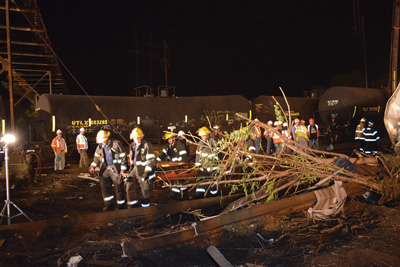
(11) A ladder company used stokes baskets to carry extrication tools to the scene. Responders used stoke baskets with backboards to ferry passengers to the two triage/treatment areas (East and West). Note the close proximity of the stored tank cars to the passenger train wreckage.
The effective fire department response to the Frankford Junction train derailment testified to the cooperation and collaboration among the Philadelphia public safety community-fire, police, emergency medical services, and others. A major rail incident is a challenge for any department. We can prepare for such an emergency by reviewing the emergency response to the Frankford Junction derailment and similar incidents. We can likely expect that our next rail accident incident will be in a hard-to-find-and-access location and will involve many injuries. We will face communications, logistics, and coordination problems. The only way we will be able to meet the challenges of tomorrow is to preplan today.
VINCENT P. MULRAY is a 27-year veteran of the fire service and a battalion chief with the Philadelphia (PA) Fire Department, assigned to Battalion 10. Before joining the department, he worked as a locomotive engineer for the Southeastern Pennsylvania Transit Authority. He has a master’s degree in public safety from Saint Joseph’s University and has completed the National Fire Academy’s Executive Fire Officers (EFO) program. Mulray is an adjunct instructor at the National Fire Academy, has been a guest lecturer with Holy Family University’s Fire Science Program, and is a frequent presenter on fireground operations.
Critical Factors Impacting Operations
BY ROBERT KENNEDY
Weather. It was a relatively warm night without precipitation, so we did not need to immediately shelter passengers and responders from rain, sleet, snow, or extreme temperatures. However, a consistent wind relentlessly blew dust and dirt into the air.
No electrical-related emergencies. Although live high-voltage electrical lines seemed to be dangling all over the derailment area, remarkably, no one suffered an electrical shock from direct contact with the lines, and objects in the area, including the derailed train and railroad tracks, did not become energized.
No additional rail traffic. At the scene, all railroad tracks, even if still intact, were obstructed by debris or people. If even only one train attempted to pass the area, passengers or responders could have been injured or the train would have derailed.
No fire. The absence of fire allowed all responders to concentrate on passenger medical care and extrication, and passengers were not exposed to smoke or high heat.
Nearby rail cars were not involved. If the Amtrak train had come in contact with the tanker cars nearby, the already complex incident could have grown worse. A hazardous material incident, a fire, or another extremely volatile event could have easily resulted.
Ease of site access. The derailment was near several access roads and ramps, not in a remote area.
No other major emergencies occurred. No other major incidents occurred during the derailment response.
Major trauma centers were close by. Medical treatment was relatively close, so victim transport was fairly quick, allowing units to return to the scene sooner or respond to other emergencies.
No responder injuries. Despite the numerous potential hazards at the site (uneven terrain, darkness, electricity, wreckage), no responders suffered any injuries.
ROBERT KENNEDY is a lieutenant with the Philadelphia (PA) Fire Department and responded to the Amtrak derailment. He has an associate degree in fire science and a bachelor’s degree in emergency planning and management.
FDNY Rescue 3 Ops at Train Derailment
CT Train Derailment and Mass Casualty Response
DC Metro Train Accident Poses Access Challenges

